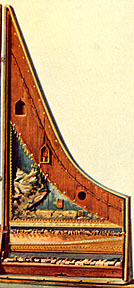Of the wire strung instruments, besides the Irish harp and possibly the citole, there is only the psaltery and its relative, the dulcimer. The term “psaltery” dates back to Greek times but the origin of the zither-type instrument familiar to us from countless medieval miniature paintings is obscure. Two medieval writers recommend silver strings for the psaltery, with bronze or brass and even gold mentioned as alternatives. The strings might have been plucked with a quill plectrum or with the fingers. One famous literary reference involving the medieval psaltery occurs in Chaucer’s Miller’s Tale, where “Nicholas the gallant” liked to accompany himself in singing “Angelus ad virginem.”
Psaltery. Paul Hillier Portrait. Paul Hillier, voice with Andrew Lawrence-King, harp and psaltery. Harmonia Mundi HMX 2907126 (1997). Trk 5 Quant voi la flor nouvele (excerpt).
Psalteries are shown in a variety of shapes including the so-called “double-wing” or “pig’s head,” a sort of in-curving trapezoid, and the Arabic qanun, also a trapezoid or half-trapezoid that can look like a miniature grand piano. Some psalteries also simple trapezoids.
In the 15th century, we find the first evidence for a kind of “mechanized psaltery” — the harpsichord. The Burgundian physician, Henri Arnaut, gave plans for such an instrument (among others) in a treatise written ca. 1440. The earliest harpsichord-like instrument to survive is an upright one — a clavicytherium — which probably fell out of favor because it required springs to work the jacks, unlike the standard horizontal harpsichords which used gravity to reposition the jacks once they had plucked the strings. It’s possible to see these early harpsichord forms as descendants of the qanun psaltery.






